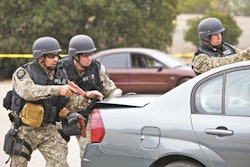It has often been said that police work is the second oldest profession. The distinction of "oldest profession" goes, of course, to prostitution.
For as long as there have been men and women, there has been the exchange of valuables for sexual favors, though there rarely have been societies that allowed prostitution. Sanctions have varied from fines to death, yet prostitution has flourished in every stratum of society in every part of the world.
Prostitution takes many different forms from high-priced call girls who meet clients in hotel rooms to street prostitutes who ply their trade in public.
This article is designed to help you formulate a strategy to combat street level prostitution. It is being presented in February when the cold weather (in many cities) typically prevents street prostitutes from being outside too long. This down time in the street prostitution trade will allow you to develop a workable plan and align the necessary resources to put into place an effective enforcement apparatus when business picks up in the spring and summer.
Traditionally, police response to street prostitution has been to arrest the prostitutes. Many of these arrests are the result of expensive and manpower-intensive street sweeps. The number of officers involved, the hours worked, and subsequent processing and court time increase the cost of each street prostitution arrest.
Street Sweeps
Besides being expensive, street sweeps do not reduce prostitution and there is a chance that the sweeps may actually increase street prostitution. When a sweep is conducted, the absence of street prostitutes creates a void that is filled by other prostitutes. Also, many of the arrested prostitutes have no way to earn money to pay fines except through prostitution. Prostitutes may be exposed to more harm by working longer hours, in unfamiliar and unsafe terrain, and entertaining riskier clients.
Lately police strategy has shifted from attacking the supply to targeting the demand. Police arrest the clients who come from neighboring towns to procure the services street workers provide. Yet this tactic alone does not effectively reduce the demand for sexual favors. Any effective policy is going to incorporate a balanced attack against the suppliers and those who demand it.
An effective police response will also consider community mores. It has been argued that prostitution is a "victimless crime" engaged by two consenting adults. But this view does not consider that street prostitution offends the moral standards of many in the community. It also does not consider the nuisance that street prostitutes and their clients create for nearby neighbors and businesses. Individuals who are neither involved nor interested in the service are forced to watch as transactions are consummated.
Prostitution also attracts strangers to a neighborhood and provides a seedbed for other street level crimes, including illegal drug use. Street prostitution and the element it attracts can have a detrimental effect on an entire neighborhood. Legitimate businesses suffer as customers avoid the area. Residents must deal with the unsightly residue: soiled condoms, condom packages, and narcotic paraphernalia. Although street prostitution accounts for only 10 to 20 percent of all prostitution, it has the largest negative impact on the community.
A police strategy should not just be concerned with the negative impact on the neighborhood, but the negative impact on the prostitutes themselves.
The Hookers
Street level prostitutes generally occupy the lowest position in the street crime hierarchy. Among prostitutes, they tend to be the oldest or youngest practitioners. They lack the skills to get any other type of work. Many times they are saddled with family bills and an addiction which makes them both desperate for work and vulnerable to exploitation.
Financial problems, domestic situations, and drug abuse lead to personal decline among prostitutes. Most report being assaulted at least once a year. Contrary to popular belief, pimps do not protect prostitutes from violent customers-only from other pimps.
A small number of clients account for the majority of assaults, which typically go unreported. Police can help prostitutes avoid assaults by providing a list of "bad dates" detailing clients prone to assault.
Most street-level prostitutes ply their trade in transitional, rundown neighborhoods where residents often lack the motivation or political voice to oppose the prostitutes' presence. Prostitutes are often found around bars, motels, or adult entertainment sites.
The Hood
Research shows that prostitutes usually work six to eight hours a day, five to six days a week. They will service three to five clients a shift. A transaction conducted outside usually takes about 10 minutes whereas one that takes place indoors usually takes 25 minutes.[PAGEBREAK]
The Johns
In designing an approach to combat street prostitution, first ascertain the extent of the problem. Are there other crimes (drugs, robberies, assaults, etc.) associated with the street prostitution? Are community activities like churches and day care centers negatively affected? What effect does the street prostitution have on local legitimate businesses? How concerned is the community with the problem?
Assemble profiles of the clients. Research has shown that about 10 to 20 percent of men have paid for sex and about one percent do so on a regular basis. Establish if the offenders are local residents or if they travel to the area.
What are their occupations? What are their socio-economic and marital status? This information will be invaluable in developing effective sanctions. Are the same clients re-arrested or is there a constant influx of new clientele?
Punishment
Research what sanctions are available and what sanctions are usually imposed on prostitutes and their clients. It is generally easy to make arrests for street prostitution, but an effective sentencing program is required to ultimately reduce the problem. Though sentencing obviously falls outside of your purview, you can make recommendations to the appropriate sentencing bodies.
If your department finds that sanctions for prostitutes and their clients are generally lenient, you may want to show the court how widespread the problem is. One tactic is to schedule all first appearances on the same date. Instead of having offenders trickle into court on different days, having many prostitutes and their customers in court at the same time will help the judge see the magnitude of the problem.
One traditional sanctioning strategy has been to shame the offender. Most good citizens do not want to be associated with the tawdry business of street prostitution. This technique is more likely to be effective with a client than a street prostitute. Many clients are family men with good jobs and respectable ties to the community. They are ashamed of their behavior and fear their public reputation will be hurt.
Another successful sentencing option dealing with clients has been "john schools." These court-ordered education programs mandate that clients of street prostitutes spend time in class learning about the legal and health consequences associated with their criminal behavior.
Research has shown that the recidivism rate for those attending "john schools" is two to seven percent. If the interesting curriculum of the "john school" is not enough to motivate attendance, clients are threatened with driver's license suspension if attendance is not completed. Another sanction imposed on non-completion of the class is publication of the john's name in a local newspaper or Website.
Rehabilitation
Your department may want to use creative methods to explain the dangers of prostitution. Pamphlets that outline the dangers of paying for sex can accompany motor vehicle warnings for minor offenses in high crime areas. You can mail similar notices to the owners of vehicles whose cars are found in high crime areas. You can also contact high-risk groups via e-mail prior to their arrival in town to warn of strict enforcement of prostitution laws and the health risks associated with street prostitution; this works best in cities that host conventions.
Cut down on the opportunities to conduct illicit sex acts by reporting abandoned buildings used by those in the sex trade. Work with the city council to secure such buildings and to restrict or eliminate motel rooms that are available by the hour. Motels could also be required to obtain positive identification from anyone staying in a room.
In dealing with the prostitutes themselves, set up programs that present apprehended offenders with opportunities to get out of the sex trade. Serve restraining orders to repeat offenders to prohibit them from returning to certain high-risk areas. Place curfews on certain prostitutes to make sure they do not work during certain peak hours. With their ability to earn money in the sex trade severely impeded, prostitutes will look for alternative forms of income.
The community policing arm of your department can work with social services to make available resources to help prostitutes quit street prostitution, including mental health, drug and alcohol treatment, and testing for HIV and other sexually transmitted diseases. The prostitute trying to get off the street will need help with food, housing, job training, and employment placement. Many street prostitutes are single parents, so child care should be considered. Only by providing a street prostitute with a viable alternative to the sex trade will we begin to see a reduction in habitual offenders.
These solutions require resources outside the scope of the criminal justice system. Anything more than a temporary solution will require a concentrated effort by several different organizations. The time to start organizing the resources is in the dead of winter when street prostitution is slow. By summertime, when the streets are teeming with sex workers, it will be too late to design and implement a program to combat street prostitution.
Det. Joseph Petrocelli is a 20-year veteran of New Jersey law enforcement. You can comment on this article, suggest other topics, or reach the author by e-mailing the editor at david.griffith@PoliceMag.com.














